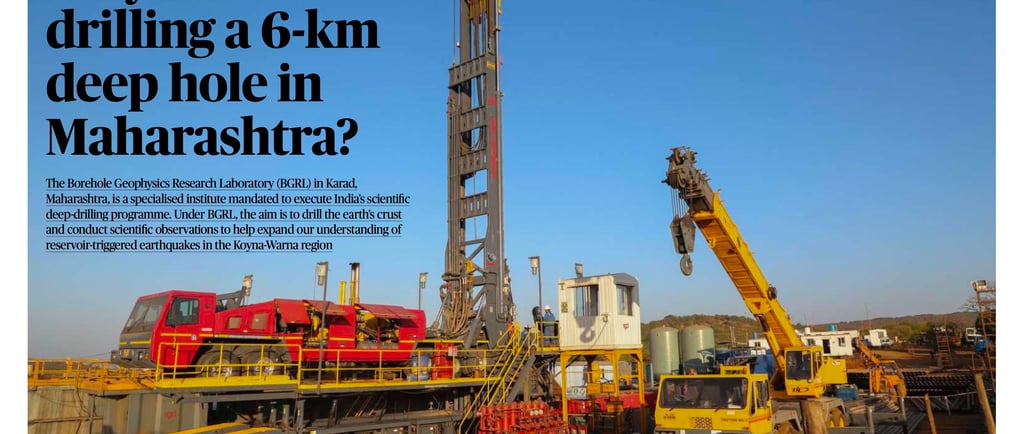India drilling a 6-km deep hole in Maharashtra?
India’s deep-drilling project in Maharashtra represents a significant step towards understanding and mitigating earthquake risks. Despite the challenges, the benefits of scientific deep-drilling are vast, contributing to geological knowledge, technological advancement, and societal safety. The project underscores India’s commitment to advancing earth sciences and addressing critical environmental and safety concerns.
Dhirendra Tiwari
7/12/20242 min read


India has embarked on a significant scientific endeavour by drilling a 6-km deep hole in the Koyna-Warna region of Maharashtra. This initiative, spearheaded by the Borehole Geophysics Research Laboratory (BGRL) in Karad, aims to advance our understanding of reservoir-triggered earthquakes and various geological phenomena.
Scientific Deep Drilling:
Definition: Scientific deep drilling involves strategically digging boreholes to study the deeper parts of the Earth’s crust. It provides insights into earthquakes, the Earth’s history, rock types, energy resources, and climate change patterns.
Purpose in Koyna-Warna Region: The primary objective is to understand reservoir-triggered earthquakes, particularly those occurring due to the impoundment of the Shivaji Sagar Lake (Koyna Dam) since 1962.
Benefits:
Enhanced Earthquake Understanding: By drilling deep into the Earth’s crust, scientists can conduct in situ experiments and observations, providing a better understanding of fault lines and seismic behaviour.
Geological Insights: The borehole allows for direct observation and measurement of the Earth’s crust composition, structure, and processes, which can validate surface-based models.
Technological Advancements: The project fosters technological innovation in drilling, data analysis, and sensor development, especially in seismology.
Challenges:
Technical Complexity: Deep drilling involves navigating high temperatures, darkness, and high-pressure environments, which complicate long-term operations.
Resource Intensive: The process is labour and capital-intensive, requiring highly skilled technical personnel for continuous engagement over extended periods.
Operational Risks: There are risks of equipment failure, such as drill rods and sensors getting stuck, especially when drilling through fractured rocks and fault zones.
Drilling Technique:
Hybrid Strategy: The Koyna borehole employs a hybrid technique combining mud rotary drilling and air hammering.
Mud Rotary Drilling: Uses a rotating drilling rod with a diamond-embedded bit, cooled by drilling mud to prevent overheating.
Air Hammering: Uses highly compressed air to deepen the borehole and flush out cuttings.
Core Sampling: Mud rotary drilling is preferred for capturing long, intact core samples, while air hammering collects rock chips for property studies.
Scientific Findings:
Geological Discoveries: The pilot borehole revealed 1.2 km thick Deccan trap lava flows and ancient granitic basement rocks.
Stress Regimes: Downhole measurements provided insights into the physical and mechanical properties of rocks, stress regimes, and fracture orientations.
Water Presence: The discovery of meteoric water at a depth of 3 km indicates deep percolation and circulation.
Future Prospects:
Deepening the Borehole: Plans to reach a depth of 6 km will require upgrading the drilling rig and managing increased operational complexities.
Broader Research Applications: The data and samples from the borehole will support various research projects, including studies on rock friction properties, microbial life in extreme environments, and carbon capture.
Issues
Unpredictability of Earthquakes: Minor earthquakes in plate interiors are difficult to predict and pose risks to densely populated areas.
Operational Challenges: High-pressure environments and fractured rocks complicate drilling and require continuous troubleshooting.
Significance
Societal Impact: Understanding earthquakes and geological processes helps mitigate risks associated with geohazards and informs policies for disaster preparedness.
Scientific Advancement: The project enhances scientific knowledge and technological capabilities, positioning India as a leader in deep-drilling research.
Solutions
Technological Innovations: Developing advanced drilling equipment and data acquisition systems to handle extreme conditions.
Skilled Workforce: Training and employing highly skilled technical personnel for continuous, on-site engagement.
Collaborative Research: Engaging national and international research groups to maximize the utilization of data and samples.

